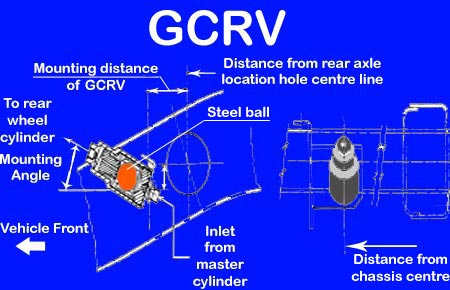What is Load Conscious Pressure Reducing Valve or LCRV?
The term LCRV stands for the Load Conscious Pressure Reducing valve. It is a safety device. Some older generation vehicles have LCRV to reduce the system pressure going to the rear wheels. An LCRV is necessary for the brake system during severe braking. That time, most of the vehicle weight is transferred to the front. Thus, the front brakes do most of the braking. As a result, the rear wheels bear little traction. In this condition, under high time pressure; they have a tendency to skid.
In order to prevent the allowed braking torque from exceeding, manufacturers fit load control pressure-reducing valves in vehicles. An LCRV is also known as a skid control or inertia valve. It consists of a steel ball housed inside the valve body which floats in the brake fluid inside the valve. The ball moves in response to the rate of deceleration in order to consume the forces causing the problem.
Working of Load Conscious Pressure Reducing Valve (LCRV):
Therefore, the system eliminates the rear wheel locking under emergency conditions such as heavy braking. However, under normal working conditions, the rate of wear & tear between the front and rear brakes is the same. Additional benefits include – The reduction of stopping distance over a wide range of load and adhesion of tires makes this valve completely ‘Fail-Safe’ in operation.

Hence, manufacturers install the LCRV valve in the line to the rear brake drums. During heavy braking, the valve limits the pressure to the wheels. The valve acts as a mechanism to reduce the line pressure to the rear wheels. This allows rear wheels to keep turning instead of locking up and skidding. This served as a basic or simple hydraulic ABS system in earlier generation cars when the electronically controlled ABS was not available. However, only the locking of rear wheels is taken into account and prevented them from occurring as compared to the front wheels.
Operation:
Furthermore, the operation of the LCRV takes place in two stages. In the first stage, the valve cuts off at the pre-determined deceleration common pressure to the front & rear brakes. Then, in the second stage, a differential diameter valve reduces the rate of increase of the hydraulic pressure the rear brakes. The angle of the ramp further controls the movement of the ball valve. Thus, it provides automatic correction of the braking ratio by the changes in the altitude of the motor vehicle. Girling is one of the manufacturers of Load Conscious Pressure Reducing Valves in the world.
Watch here how the LCRV works:
What is ‘G’ Conscious Pressure Reducing Valve or GCRV?
Furthermore, the term GCRV stands for Gravity Conscious Pressure Reducing valve. This valve comprises a barrel with one inlet and one outlet. It has a steel ball rolling free inside the barrel. When the driver applies brakes, the brake fluid going to rear wheel cylinders will pass through this valve around the steel ball. It will go out from the other end to rear wheel cylinders.
How does GCRV work?
Furthermore, as the brakes get actuated and the vehicle slows down, the free-rolling ball moves forward due to its momentum. Thus, it closes the oil port stopping the further supply of brake fluid to rear wheel cylinders. This will ensure that the cylinder pressure limits to the value which avoids wheel locking. To achieve the specific cutout point the valve body is mounted on the vehicle at 280 degrees fixed angle. This is so because the ball has to climb some slope before closing the outlet port.

For more information on Load Conscious Pressure Reducing Valve, watch this video:
Read More: How Hill Holder device works?>>
